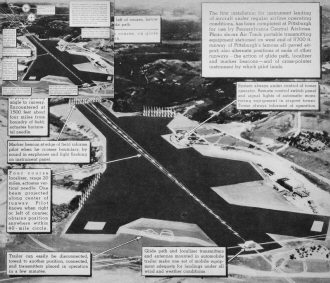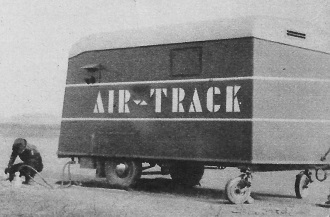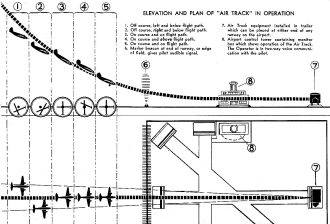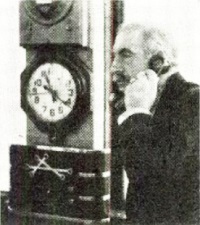|
Only three and a half decades had
passed since the Wright Brothers made the first flight of an aeroplane taking
off under its own power when this "Blind Landing" article appeared in a 1938
issue of Radio News magazine. By then, an entire World War had been
fought with air power having been determined to be a primary strategic force,
and a commercial airline industry was thriving as travelers everywhere entrusted
pilots and air traffic controllers with their very lives. The main
impediment holding back further progress from an navigational and scheduling
perspective was inclement weather. Pilots had long ago learned to fly by
instruments, and taking off into nearly zero visibility was not a problem, but
landing confidently and safely under the same conditions was still impossible.
Aviation researchers were hard at work trying to devise an instrument landing
system (ILS) which would guide pilots to the runway threshold by providing
electronically via narrowly focused radio beacons whose signals were measured
and presented on cockpit instruments. Glide slope (elevation) and course line
(azimuth) together creates a three-dimensional representation of the aircraft's
position in space, and all the pilot needs to do is keep the needles centered
until the runway is visible. At that point the airplane is flown in a normal
manner to touchdown. That, of course, is easier said than done. Even in
perfectly calm weather conditions a lot of skill is required to stay on the
directed path, but throw in wind, wind gusts, rain, lightning, snow, and other
variables and the job gets a lot tougher. Add to that the fact that just as a
primary tenet of General Relativity asserts, there is no way to differentiate
between acceleration due to gravity and acceleration due to a change in speed
and you have a situation where without a visual reference outside the cockpit,
he cannot tell for instance whether a particular G-force is due to being upright
and level or to being upside down and flying a parabolic course toward the
ground. That explains the aviator's admonition to "die by your instruments,"
meaning it is usually better to ignore your "gut" feeling and trust what the
instruments say since when properly interpreted they are more reliable.
Landing Blind

Radio eliminates one of the great hazards of aviation by making
possible a safe landing in "zero-zero" weather.
by C. S. Van Dresser
For years it has been the dream of aviation experts throughout the world to perfect
a blind landing device that works. Not that several of the inventions in the past
do not offer some degree of exactness and reliability and are a distinct aid to
aviation; but what was wanted was a device that would function perfectly - that
would guide the pilot to an absolutely safe landing even if the field were blanketed
by dense fog and not a floodlight would work.
A difficult task to develop such a device, but not an impossible one, for it
appears at last that this dream of aviation has become a reality.
The story started ten years ago in the National Bureau of Standards, Uncle Sam's
great scientific laboratory in Washington. In 1928 this vital work was undertaken
by a group of brilliant young scientists of the Bureau and carried to partial completion
in 1933. Then the necessary appropriations ran out, and the Washington Institute
of Technology took over, engaged the same scientists, and carried on.

The photo-schematic diagram above shows how the Air Track blind
landing system functions for Pennsylvania Central Airlines at the Municipal Airport
at Pittsburgh. Marker beacons are installed at the ends of all runways. The transmitter
trailer may be towed to the opposite end of any runway it is necessary for the incoming
plane to use (due to the direction from which the wind is blowing), plug in on the
power line, and send forth its localizer and glide-path beams. By the use of the
"cross-pointer" instrument the pilot can then guide his plane down to a safe landing,
even though visibility be limited to a short distance in front of his ship.

The "cross-pointer" instrument keeps the pilot informed at all
times of his plane's position in relation to the glide-path beam. (1) Indicator
shows that plane is to the left of the course beam which marks the center of the
runway, and above the glide-path beam which brings the ship gently to earth along
a curved track. (2) Indicator shows plane is to the right of the course and below
glide-path. (3) The incoming plane is now on course but is below the glide-path.
(4) The pilot now has the plane on course and on the glide-path. By keeping the
needles in this position the pilot can bring his plane down to a safe landing with
its cargo of passengers, air mail and express.

This trailer houses the radio equipment for the localizer and
glide path beams.

Elevation and Plan of "Air Track" in Operation.
1. Off course, left and below flight path.
2. Off course, right and below flight path.
3. On course and on flight path.
4. On course and above flight path.
5. On course and on flight path.
6. Marker beacon at end of runway, or edge of field, gives pilot
audible signal.
7. Air Track equipment installed in trailer which can be placed at
either end of any runway on the airport.
8. Airport control tower containing monitor box which shows operation
of the Air Track. The Operator is in two-way voice communication with the pilot.

The monitor in the airport's control tower.
For four more weary years the painstaking work continued, until today it can
be announced that the job at last has been successfully completed. With new developments
perfected at the Institute, for the first time in the history of the world a blind
landing device is in actual commercial operation. It is being used daily by Pennsylvania
Central Airlines at the municipal airport in Pittsburgh.
The equipment consists of three radio transmitters and antennae located on the
ground and the necessary equipment in the plane to indicate signals from them. The
ground antennae actually produce a so-called curved beam, or radio track down which
the plane glides to land gently and securely on the runway.
Two of the ground transmitters and antennae are housed in an automobile trailer.
These give the incoming pilot vertical and horizontal guidance. The third transmitter
and antenna are located at the approach end of the runway and throw up a vertical
radio "curtain" through which the plane passes.
To receive the signals the plane is equipped with a cross pointer instrument
which is a dial with two needles, one to indicate whether it is to the right or
left of the air track, and the other to tell if it is too high or too low. One of
the radio beams is projected in a straight line down the center of the runway on
which the plane will land.
The horizontal guidance transmitter, or localizer as it is called, is in effect
a miniature range beacon with four distinct courses, each separate course with a
range of twenty miles or better. When the pilot approaches the airport, the vertical
needle informs him whether he is aiming his ship correctly on this particular beam.
When this needle points directly up, the plane is headed precisely for the runway,
and the pilot is in a position to receive signals as to his altitude.
This is where the horizontal needle on the cross pointer instrument comes in.
All the pilot has to do is maneuver his ship until the two needles are at exact
right angles and he will come out of the sky in a gentle glide to make a safe and
easy landing.
The transmitter, located at the approach end of the runway, which sends up the
vertical curtain, referred to previously, is known as the marker beacon. As the
plane passes through this curtain, the pilot receives a signal in his earphones
and a light flashes on his instrument panel. Thus he knows he is crossing the boundary
of the field at a known altitude, at which point he cuts the throttle and simply
follows the glide-path which leads him gently to the ground.
Two-way radio communication between the pilot and the operator of the airport
control tower is not interrupted at any time during the landing procedure.
As a further check in safety, the complete operation of the entire air track
system is constantly under the observation of the operator of the control tower.
An ingenious monitoring device, with lights to correspond to the various air track
radio beams, instantly informs the tower control man of the operation of all ground
equipment.
One of the most amazing properties of the curved beam set-up is its complete
maneuverability. As we know, planes must land into the wind. Landing in a violent
cross wind might prove fatal to these leviathans of the air.
Suppose, for instance, a 30 mile gale is blowing from North to South which is
directly in line with the long runway of an airport. That would mean that the plane
must land facing North, or into the wind. Half-an-hour before the ship arrives,
the wind changes direction, blowing from East to West. With stationary equipment,
Air Track would be of no avail, and the pilot would be forced to land in the regular
manner, either by sight in the daytime, or floodlights at night. (Naturally if visibility
was too poor, the plane would have been grounded.)
However, with this new system the trailer with necessary ground equipment can
be shifted at a moment's notice. All that has to be done it to hitch a tractor to
it and tow it to any position desired and plug in to the airport's electrical system.
It is ready then to guide the plane to the field on a different runway.
Another advantage of the new system is that it presents practically no obstruction
to departing or arriving transports. Some landing fields are menaced by dangerous
obstructions such as radio towers, high tension wires and the like. The trailer,
situated at one end of the field, is but eight feet in height. The beam insures
any incoming plane plenty of clearance, while a ship taking off, which might be
headed directly at it, has the entire length of the field to dear eight feet. If
a pilot can't make that altitude. in a half-mile runway, he's in trouble. already.
Officials and scientists of the Washington Institute of Technology point out
positively that the flights and landings now taking place at the Pittsburgh airport
are not experiments, not demonstrations, and not tests of any nature. As Dr. Frank
G. Kear of the Institute states: "This is the emergence of instrument landing from
the demonstration stage to that of pilot training during scheduled airline operations.
The air track system has been developed over a period of nine years. It is now in
actual service."
During the nine years of development, many hazardous experiments were undertaken
at the laboratory and airport which are located at College park, Maryland, just
outside of Washington, D. C., near the University of Maryland. Courageous and skillful
pilots risked their lives in testing various phases of the instruments. Literally
thousands of landings were made, many "under the hood" when the pilot could see
nothing but his instrument panel. Some of the birdmen received severe jolts and
bruises due to inaccuracies which in time were corrected, but no one was seriously
hurt and no one was killed.
Colonel Charles Lindbergh later flew the bent beam, as it was called then, at
Newark and expressed great interest in the development to date. The highlight of
the early demonstrations was the flight by James L. Kinney, Department of Air Commerce
pilot, from College Park to the Newark airport. This epochal aerial journey was
undertaken when every plane in the East was grounded due to one of the heaviest
fogs in years. Pilot Kinney took off in this fog, flew to Newark, and landed without
ever having seen the ground. It was the first actual zero-zero, cross-country flight
ever made.
According to W. E. Jackson, Chief of the Radio Development Section of the Bureau
of Air Commerce, an amendment to the Air Commerce Act of 1926 will be presented
at this session of Congress to make possible the expenditure of addition Federal
funds on airports as well as airways. This will make possible the installation of
blind landing equipment at every important airport in the United States.
Credit for the evolution of the curved beam system goes to Harry Diamond, radio
expert of the National Bureau of Standards; Gomer L. Davis and Dr. Frank G. Kear,
formerly of the Bureau and now with the Washington Institute of Technology; W. E.
Jackson, of the Bureau of Air Commerce and Pennsylvania Central Air Lines.
As their motto, the men of science who have developed their newest aid to safety
in the air, have adopted these words, "A safe flight must end in a safe landing."
Posted January 13, 2022
|















